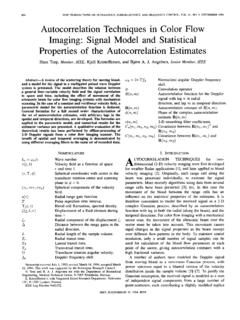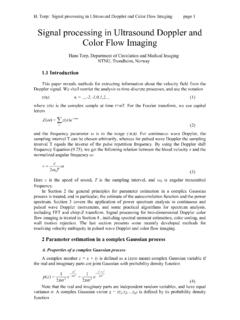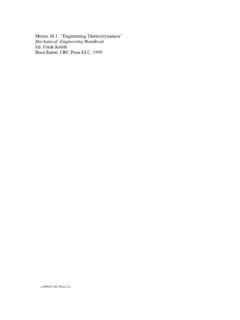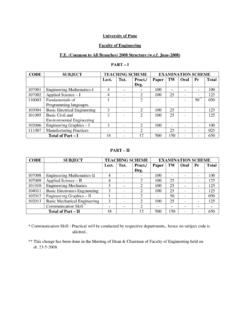Transcription of Distillation Theory - NTNU
1 19 Draft - /home/ivarh/thesis/ : 11 August 2000 Chapter 2 Distillation TheorybyIvar J. Halvorsen and Sigurd SkogestadNorwegian University of Science and TechnologyDepartment of Chemical Engineering7491 Trondheim, NorwayThis is a revised version of an article acceptedfor publication in the Encyclopedia of SeparationScience by Academic Press Ltd. (submitted in1999). This article gives some of the basics ofdistillation Theory and its purpose is to providebasic understanding and some tools for simple handcalculations of Distillation columns. The methodspresented here can be used for simple estimates andto check more rigorous - /home/ivarh/thesis/ : 11 August is a very old separation technology for separating liquid mixtures thatcan be traced back to the chemists in Alexandria in the first century Todaydistillation is the most important industrial separation technology.
2 It is particu-larly well suited for high purity separations since any degree of separation can beobtained with a fixed energy consumption by increasing the number of equilib-rium describe the degree of separation between two components in a column or ina column section, we introduce the separation factor:( )where herexdenotes mole fraction of a component, subscriptLdenotes lightcomponent,Hheavy component,Tdenotes the top of the section, is relatively straightforward to derive models of Distillation columns based onalmost any degree of detail, and also to use such models to simulate the behaviouron a computer. However, such simulations may be time consuming and often pro-vide limited insight. The objective of this article is to provide analyticalexpressions that are useful for understanding the fundamentals of Distillation andwhich may be used to guide and check more detailed simulations: Minimum energy requirement and corresponding internal flowrequirements.
3 Minimum number of stages. Simple expressions for the separation derivation of analytical expressions requires the assumptions of: Equilibrium stages. Constant relative volatility. Constant molar assumptions may seem restrictive, but they are actually satisfied for manyreal systems, and in any case the resulting expressions yield invalueable insights,also for systems where the approximations do not ()TxLxH ()B------------------------= Fundamentals21 Draft - /home/ivarh/thesis/ : 11 August Equilibrium Stage ConceptThe equilibrium (theoretical) stage concept (see Figure ) is central in distilla-tion. Here we assume vapour-liquid equilibrium (VLE) on each stage and that theliquid is sent to the stage below and the vapour to the stage above. For some trayedcolumns this may be a reasonable description of the actual physics, but it is cer-tainly not for a packed column.
4 Nevertheless, it is established that calculationsbased on the equilibrium stage concept (with the number of stages adjusted appro-priately) fits data from most real columns very well, even packed : Equilibrium stage may refine the equilibrium stage concept, by introducing back mixing ora Murphee efficiency factor for the equilibrium, but these fixes have often rela-tively little theoretical justification, and are not used in this practical calculations, the critical step is usually not the modelling of thestages, but to obtain a good description of the VLE. In this area there has beensignificant advances in the last 25 years, especially after the introduction of equa-tions of state for VLE prediction. However, here we will use simpler VLE models(constant relative volatility) which apply to relatively ideal Equilibrium (VLE)In a two-phase system (PH=2) withNcnon-reacting components, the state is com-pletely determined byNcdegrees of freedom (f), according to Gibb s phase rule.
5 YxPTVapour phaseLiquid phaseSaturated vapour leaving the stageSaturated liquid leaving the stagewith equilibrium mole fractionxwith equilibrium mole fractionyand enthalpyhL(T,x)and molar enthalpyhV(T,x)Liquid entering the stage (xL,in,hL,in)Vapour entering the stage (yV,in,hV,in)Perfect mixingin each phase22 Draft - /home/ivarh/thesis/ : 11 August 2000( )If the pressure (P) andNc-1liquid compositions or mole fractions (x) are used asdegrees of freedom, then the mole fractions (y) in the vapour phase and the tem-perature (T) are determined, provided that two phases are present. The generalVLE relation can then be written:( )Here we have introduced the mole fractions x and y in the liquid an vapour phasesrespectively, and we trivially have andInidealmixtures, the vapour liquid equilibrium can be derived from Raoult s lawwhich states that the partial pressurepiof a component (i) in the vapour phase isproportional to the vapour pressure () of the pure component (which is a func-tion of temperature only:) and the liquid mole fraction (xi):( )For an ideas gas, according to Dalton s law, the partial pressure of a componentis proportional to the mole fraction:, and since the total pressure we derive:( )The following empirical formula is frequently used for computing the pure com-ponent vapour pressure.
6 ( )fNc2P H+= T,, ,,[] ,,, ,()=yT,[]fPx,()=xii1=n 1=yii1=n 1=piopiopioT()=pixipioT()=piyiP= +++pii xipioT()i ===yixipioP------xipioT()xipioT()i ---------------------------==poT()lnabcT +------------dT()lneTf++ + Fundamentals23 Draft - /home/ivarh/thesis/ : 11 August 2000 The coefficients are listed in component property data bases. The case withd=e=0is called the Antoine and Relative VolatilityTheK-value for a componentiis defined as:. The K-value is some-times called the equilibrium constant , but this is misleading as it dependsstrongly on temperature and pressure (or composition).Therelative volatility between componentsi andj is defined as:( )For ideal mixtures that satisfy Raoult s law we have:( )Heredepends on temperature so the K-values will actually be constantonly close to the column ends where the temperature is relatively constant.
7 On theother hand the ratiois much less dependent on temperature whichmakes the relative volatility very attractive for computations. For ideal mixtures,a geometric average of the relative volatilities for the highest and lowest temper-ature in the column usually gives sufficient accuracy in the computations:.We usually select a common reference componentr(usually the least volatile (or heavy ) component), and define:( )The VLE relationship ( ) then becomes:( )Kiyixi = ijyixi ()yjxj ()------------------KiKj------== ijyixi ()yjxj ()------------------KiKj------pioT()pjoT ()---------------===pioT()pioT()pjoT() ij ij top, ij bottom, = i irpioT()proT() ==yi ixi ixii -----------------=24 Draft - /home/ivarh/thesis/ : 11 August 2000 For a binary mixture we usually omit the component index for the light compo-nent, we writex=x1(light component) andx2=1-x(heavy component).
8 Thenthe VLE relationship becomes:( )This equilibrium curve is illustrated in Figure :Figure : VLE for ideal binary mixture:The differencey-xdetermine the amount of separation that can be achieved on astage. Large relative volatilities implies large differences in boiling points andeasy separation. Close boiling points implies relative volatility closer to unity, asshown below the Relative Volatility From Boiling Point DataThe Clapeyron equation relates the vapour pressure temperature dependency tothe specific heat of vaporization () and volume change between liquid andvapour phase ():y x1 1 ()x+------------------------------=Incre asing Mole fraction011xyof light componentin liquid phaseMole fractionof light componentin vapour phase =1y x1 1 ()x+------------------------------=Hvap Vvap Fundamentals25 Draft - /home/ivarh/thesis/ : 11 August 2000( )If we assume an ideal gas phase, and that the gas volume is much larger than theliquid volume, then, and integration of Clapeyrons equationfrom temperatureTbi(boiling point at pressurePref) to temperatureT(at pressure) gives, when is assumed constant.
9 ( )This gives us the Antoine coefficients:.In most cases. For an ideal mixture that satisfies Raoult s law wehave and we derive:( )We see that the temperature dependency of the relative volatility arises from dif-ferent specific heat of vaporization. For similar values (), theexpression simplifies to:( )Here we may use the geometric average also for the heat of vaporization:( )dpoT()dT------------------Hvap T()TVvapT() ----------------------------=Vvap RT P pioHivap pioln HivapR----------------1 Tbi-------- Prefln+ HivapR---------------- T-------------------------+ ai HivapR----------------1 Tbi-------- Prefln+=bi, HivapR---------------- =ci,0=Pref1 atm= ijpioT()pjoT() = ijln HivapR----------------1 Tbi-------- HjvapR----------------1 Tbj-------- Hjvap Hivap RT-------------------------------------- -+= Hivap Hjvap ijln HvapRTb------------------ TbjTbi Tb----------------------where TbTbiTbj= Hvap HivapTbi() HjvapTbj() =26 Draft - /home/ivarh/thesis/ : 11 August 2000 This results in a rough estimate of the relative volatility, based on the boilingpoints only.
10 Where( )If we do not know, a typical value can be used for many :For methanol (L) and n-propanol (H), we haveand and the heats of vaporization at their boiling pointsare kJ/mol and kJ/mol respectively. Thus gives and which is a bit lower than the Balance on a Distillation StageBased on the equilibrium stage concept, a Distillation column section is modelledas shown in Figure : Note that we choose to number the stages starting fromthe bottom of the column. We denoteLnandVnas the total liquid- and vapourmolar flow rates leaving stagen(and entering stagesn-1andn+1, respectively). ij ije TbjTbi ()Tb HvapRTB----------------= Hvap 13 354K==Hvap HvapRTB 354 () 354 Fundamentals27 Draft - /home/ivarh/thesis/ : 11 August 2000We assume perfect mixing in both phases inside a stage. The mole fraction of spe-ciesiin the vapour leaving the stage withVnisyi,n, and the mole fraction inLnisxi, : Distillation column section modelled as a set of connectedequilibrium stagesThe material balance for componenti at stagenthen becomes (in [mol i/sec]):( )whereNi,nin the number of moles of componention stagen.
















